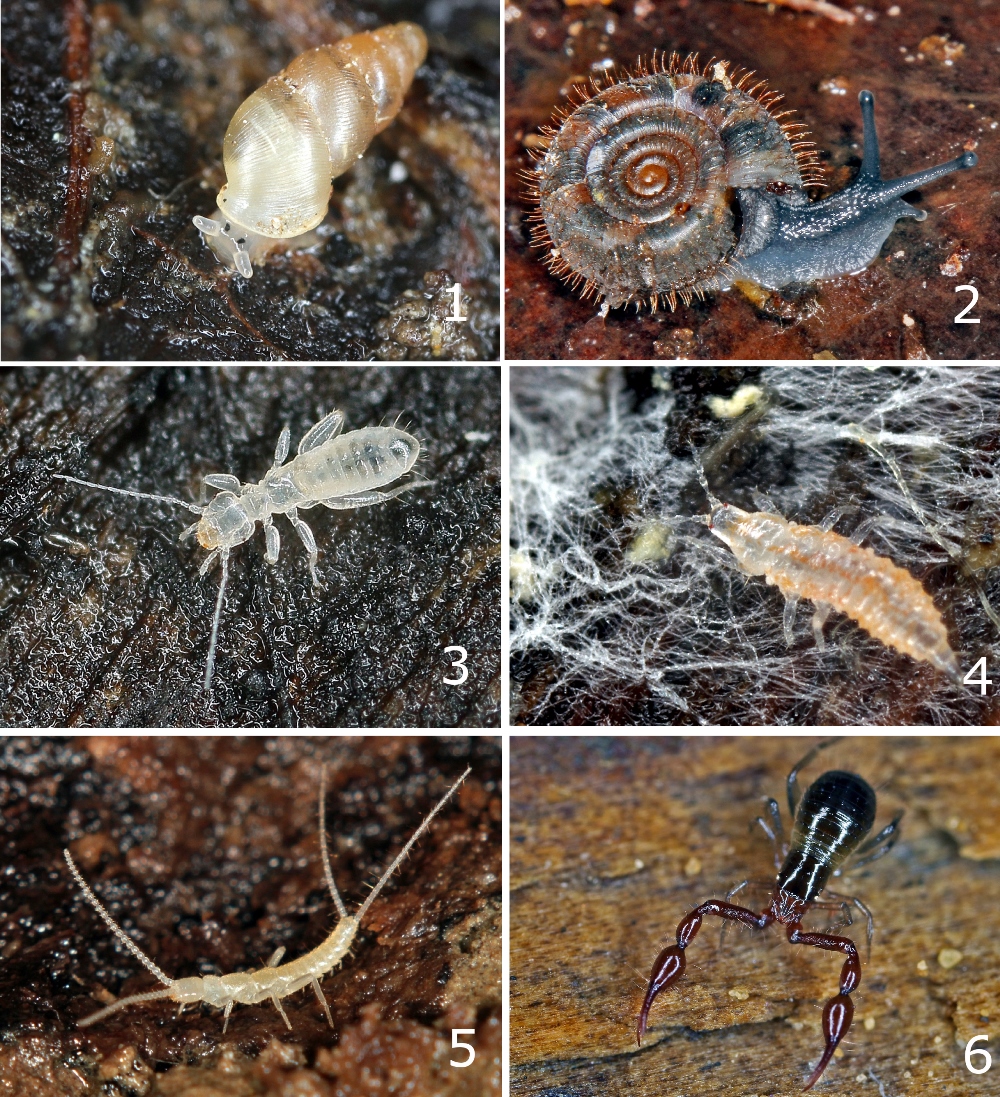Foreword: The article on soil formation, published on this site, although very succinct, is appreciated. I therefore wanted to extend it, to emphasize the importance of knowledge of soils.
It is through the European Atlas of Soil Biodiversity , the AFES website or publications by Clément Mathieu , an eminent soil scientist, that I will address here an area that I am partially discovering. Indeed, soils, on which we depend much more than one might imagine at first glance, are little known, both in their physical constitution and in the interactions of all kinds that take place there. By observing the ground, we see some of the fauna that inhabits it evolving. But the majority of organisms and the mechanisms that make it live remain hidden from view and are only revealed on dimensional or temporal scales that escape our perception. This is perhaps one of the reasons for our lack of knowledge on the subject.
Trying to sweep away, in a few lines, the issues and problems relating to soils can only be, in the context of this site, a reductive approach. This is why the reader will only find here a very partial overview of the subject here.
1) The soil, a fragile heritage:
Soils cover almost a third of our planet. A complex and dynamic ecosystem, it has not always been perceived commensurate with the immense range of resources it contains.
The soil is home to a great diversity of organisms which maintain a close relationship of interdependence with it. It is a reservoir of organic matter, nutrients and water, which man has exploited since ancient times to meet his food and domestic needs, or to extract energy resources, minerals as well as land and rocks used as construction materials or used in their composition. However , the man who exploits these soils has little knowledge of this heritage which he still too frequently reduces to land value (real estate, agricultural, forestry, mining, etc.), while the soil is also a complex mineral and organic organization, in constant mutation which serves as a habitat for a multitude of animal and plant species . In his perception of soils, man can be satisfied with what he sees at the risk that a good part of what the soil is escapes it. This is the case, for example, in rural areas where the soil is often hidden by a plant cover (meadows, moors, forests, etc.).

In urban areas, the ground, although present, is hidden under concrete or other coverings which cover most of the spaces.

When it is bare, the ground reveals a homogeneous surface which bears few visible indications on the nature of the horizons which constitute it or the transformations which take place there. The original material and the lower strata of the soil are generally only discovered during work (road trenches, quarry fronts, archaeological excavations, etc.).
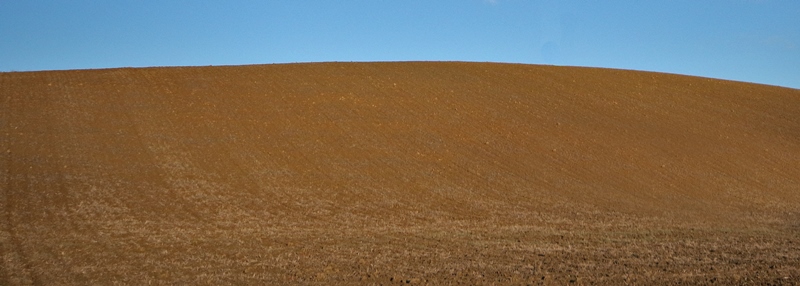
Understanding a soil requires a detailed study, with a view to establishing a map.
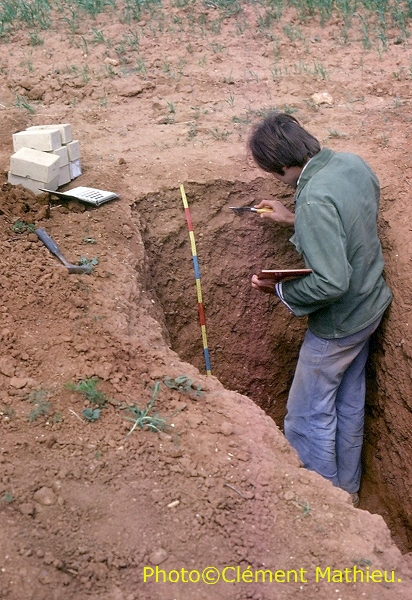 To do this, the soil scientist (opposite) digs “soil pits” whose average depth is around 1 to 2 meters. He establishes morphological inventories and takes samples, ideally going down to the outcrop level of the underlying parent rock.
To do this, the soil scientist (opposite) digs “soil pits” whose average depth is around 1 to 2 meters. He establishes morphological inventories and takes samples, ideally going down to the outcrop level of the underlying parent rock.
Analyzes carried out in the laboratory subsequently provide information on the physicochemical and bacteriological composition of the soil. These analyzes also make it possible, depending on the results obtained, to bring them closer to pre-established models which make it possible to categorize the different horizons encountered.
I cannot help but note here a certain analogy with the taxonomic approach.
INRAE/IGN soil mapping accessible online: https://www.inrae.fr/actualites/nouvelle-carte-sols-france-accessible-tous
Constantly subject to a set of phenomena and alterations, soils are eroded, compacted, attacked by acid rain, salinized, poisoned by pesticides and heavy metals from fossil fuels, but also by the spreading of organic residues from agriculture or from the agro-food industries… Beyond natural erosion linked to the climate, the human footprint becomes a determining element in the evolution of soils.
2) Historical background:
Since his appearance, man has always been in relationship with the soil. However, his awareness of what soil is in its entirety was not easy, as it was dependent on progress in knowledge in geology, chemistry, biology or more broadly in life.
The 18th century (Century of Enlightenment) was, in this regard, a pivotal period from which knowledge not only developed, but also spread to reach a wider audience, notably thanks to the work of encyclopedists.
I quote here Clement Mathieu 1 :
“ Awareness of the existence of the soil as an organized natural formation, subject to functioning and evolution, susceptible to slow and/or rapid transformations as well as irreversible degradation, took a very long time to appear.
Although the authors of Antiquity did mention some physical methods of improving agricultural soil, they had enormous difficulty in understanding the chemical role of the soil. The Middle Ages perpetuated the ideas of the Greco-Roman world and even Olivier de Serres 2 , in 1600, still ignored the role of fertilizing elements. The first real progress only appeared in 1750. Duhamel de Monceau 3 placed emphasis on working the soil and Wallerius 4 affirmed the primordial importance of humus in plant nutrition.
With Liebig 5 , Boussingault 6 and Lawes 7 (around 1840), soil chemistry took triumphant birth and we did not ignore the alteration of rocks as a formation factor.
At the end of the 19th century, Dokouchae 8 in Russia with the study of Chernozem in the plains of Ukraine, but also Müller 9 in Denmark and Hilgard 10 in the United States finally tackled the joint and dialectical study of the whole characteristics of the environment (Boulaine, 1989). Pedogenesis and soil mapping were born.
The soil is therefore no longer considered as a material, a residue of the transformation of rocks, but as a natural entity. It is a structured material complex endowed with cyclical regimes (daily and annual) which evolves over time and whose characters are related to the distribution of differentiating factors. The soil is “endowed with historicity and geography ” ( Boulaine , 1989).
From that moment on, agronomic institutions were set up. At the same time, the fertilizer industry, that of agricultural machinery, and drainage unions are gradually developing. The demand for knowledge about soils is growing little by little. But it was especially from 1950 (so, quite late) that research, inventory and design offices on soils multiplied. If at the same time progress in physicochemical and other techniques (soil microscopy, clay mineralogy, remote sensing, statistical data processing) develops as well as soil inventory, all this research does little to popularize knowledge of soils, no only for the general public, but also for the main users of this resource.
However, research applications are widely exploited in terms of fertilization, tillage, drainage, irrigation, reforestation plans, etc. as well as in soil conservation .
For more information : The article “Abridged History of Soil Science” by Jean Boulaine can be downloaded here .
3) Elements of semantics:
It appears that the lexical field which defines what we call "soil" today has evolved over time, due to the factors mentioned, but also, in relation to the latter's potential in terms of food resources.
In old documents, I noted that the term “soil” did not come into use until the end of the 18th century. For example, below, the definition found in the “Universal Reasoned Dictionary of Natural History” volume.13- p.376 by M. Valmont-Bomare 1791.

It is enough to consult the Encyclopedia of Diderot and d'Alembert ( Ed; 1751 volume 16, p 166-182 ) to note that the term "soil" does not cover the use we make of it today. To find mention of “soil” in its current definition, one must instead refer to the term “earth”.
4) The earth, “ground” of lights:
The entire definition that I reproduce here may seem tedious due to its length, but reading it teaches us a lot about the way in which soils were considered before the advent of work carried out by the researchers cited previously by Clément Mathieu.
Here is what we read in the aforementioned encyclopedia:
“ Earth, layers of the, (Hist. nat . Mineralogy.) strata telluris ; We call layers of the earth the different beds, or banks of earth, stones, sand, etc. of which our globe is composed. As soon as we observe nature, we realize that the globe we inhabit is covered with a large number of different substances, arranged in horizontal layers and parallel to each other, when some extraordinary cause has not put obstacle to this parallelism. These layers vary in different places, for the number, for their thickness, and for the quality of the materials they contain; in some areas, when digging at a very great depth, we will only find two, three, or four different layers; while in others we will find thirty or forty layers placed one above the other. Some layers are purely composed of earth, such as clay, chalk, ocher, etc. others are composed of sand and gravel; others are filled with pebbles and pebbles, or rounded stones, similar to those found on the banks of seas and rivers; others contain fragments of rocks which were torn from elsewhere & brought together in the places where they are currently found; other layers are composed only of solid rock, which occupies a space of land sometimes very considerable; these rocks are not everywhere of the same nature of stone; sometimes it is limestone, sometimes it is gypsum, marble, alabaster, sandstone, schist, or slate, and often it happens that the rock which forms a layer is itself composed of several benches, or beds of stones, which differ from each other: we find layers which are filled with bituminous materials; this is how coal mines are. Others are a mass of saline materials; this is how natron and rock salt are found.
Finally, several layers are only masses of metallic substances and mines which seem to have been transported by water to the places where we find them, after having been torn from the places where they had originated. All these different layers are sometimes filled with shells, madrepores, marine bodies, wood, & other vegetable substances, bones of fish & quadrupeds, & a large number of bodies entirely foreign to the earth.
All these circumstances which accompany the layers of the earth have always exercised the imagination of physicists; they sought to explain the arrangement that they noticed there, and the other phenomena that they present: the horizontal position of most of these layers, and the parallel situation that they observe between them, made it easy to sense that only the waters could have given them this uniform arrangement. A very simple experiment is enough to confirm this idea; if we throw a few handfuls of earth, sand, gravel, etc. into a vase full of water, each of these substances will be deposited there sooner, or later, due to its specific gravity, and the whole will form several layers which will be parallel to each other: this established, we concluded that it was necessary that the layers of the earth would also have been formed by substances which had been diluted in an immense fluid, from where they were successively deposited. As history has not preserved for us the memory of a more universal flood than that of the deluge, naturalists have had no difficulty in regarding it as the sole author of the layers of the earth; among those who have adopted this sentiment, Woodward ranks first; he supposes that the waters of the flood soaked and diluted all parts of our globe, and that when the waters withdrew, the substances they had soaked were deposited and formed the different beds of which we see the earth composed. This hypothesis, more ingenious than true, had a large number of followers; However, if we pay attention to it, we will see that the supposed drenching of the entire mass of our globe is a very chimerical idea. Furthermore, it is not true that the layers of the earth were deposited because of their specific gravity, seeing that often some of these layers, composed of lighter substances, are below layers composed of materials heavier.
In general, the flood is not capable of explaining the formation of the layers we are talking about; it cannot be denied that he produced some of them; but it would be a mistake to attribute them all to him indiscriminately, as some authors have done. Indeed, how can we conceive that a temporary flood, which, according to the story of Moses, did not even last a year, could have produced all the layers of substances so different, of which the different parts of our globe are composed?
The most probable opinion on the formation of the layers of the earth is that which attributes the greatest part to the stay of the seas which have successively, and for several centuries, occupied the continents which are inhabited today. It is at the bottom of these seas that the different substances that their waters had soaked were gradually deposited; the rivers which flow into the seas constantly carry silt which cannot fail in the long run to form immense deposits, which raise the bed of these seas, and force them to flow towards other places. Our globe being exposed to continual revolutions, must have changed its center of gravity, which caused the inclination of its axis to vary, & this movement could have been enough to dry up some portions of the globe, & to submerge others. others. The arrangement & nature of some layers of the earth even provide us with convincing proof that the waters of the sea have covered & abandoned the same places on the earth several times.
However, it would be a mistake to attribute to the sea alone the formation of all the layers that we see on the earth; the overflows of rivers carry a prodigious quantity of silt onto the land they flood, which after several centuries forms beds that the eye can easily distinguish, and by which one could count the number of overflows of these rivers. , whose bed itself is often forced to change.
Some countries present to the eye layers of a very different nature from that of which we have spoken so far; these layers are immense piles of ashes, calcined & vitrified stones, pumice stones, etc. It is easy to see that these kinds of layers were not produced by water; they are the work of underground fires and volcanoes, which in different eruptions vomited these materials at intervals sometimes very distant from each other: such are the layers that we find in Sicily near Mount Etna, in Italy near Mount Vesuvius, in Iceland near Mount Hekla, &c. it is the inspection of these kinds of layers, which made Lazzaro Moro believe, that all the layers of the earth had only been produced by volcanoes, from which we see that he extended to all our globe the phenomena which only existed in the country it inhabited, and in others which are subject to the same revolutions.
A large number of mountains are formed only from an assembly of layers of earth, stones, sand, etc. placed one above the other. We showed how they differ from primitive mountains, which are as old as the world. The layered mountains are of a more recent formation than the others, since they often contain substances which are only debris from the primitive mountains. Some of the mountains, composed of layers, are often very high. Mr. Sulzer made an observation in Switzerland which proves that they were once covered by water; in fact this learned naturalist found that Mount Rigi was covered with a layer, composed of a pile of pebbles & rolled stones of all kinds of species, & linked by a sandy & loamy gluten, which did not make it only one mass.
With regard to the deposit which formed the layers of the earth, it was not always made in the same way; sometimes this deposit was made in calm waters and on a level bottom; then the layers produced by this deposit were found to be horizontal and united; but when the deposition took place in violently agitated waters, these layers had inequalities, which is why we sometimes encounter beds in which we notice bumps and undulations, and substances in disorder and mixed together. . When the deposition of the soaked materials carried by the waters took place against the rump of a primitive mountain, the layers which were deposited must necessarily have taken the same inclination as the ground which served as support; hence comes the inclination that we notice in certain layers.
Finally we notice that the layers of the earth are sometimes broken and interrupted in their course; it seems natural to attribute these interruptions to the tremors caused by earthquakes, by the subsidence of certain lands, caused by the excavations made by groundwater. »
It is clear that encyclopedists approached soils as an essentially mineral organization. It should be noted that the flood is still mentioned, although more solidly supported explanations, established on the basis of observations, contribute to relegating the biblical event to an epiphenomenon, if indeed it has not yet been refuted. (let us not forget that this century will have allowed the scientific approach to impose itself in the face of the dogma which has persisted since scholasticism).
It was therefore necessary to wait until the 19th century for soils to be considered as an organo -mineral entity.
5) Cultivated soils:
In 2020, cultivated soils ensured the production of food resources for 8 billion human beings, approximately ten times more than the estimated population in 1800. Such a demographic upheaval could only impact the agricultural techniques implemented but above all, it has exploded the influence of agricultural areas on the surface of the globe.
The table below 11 illustrates this expansion from the beginning of the 16th century until 2017.
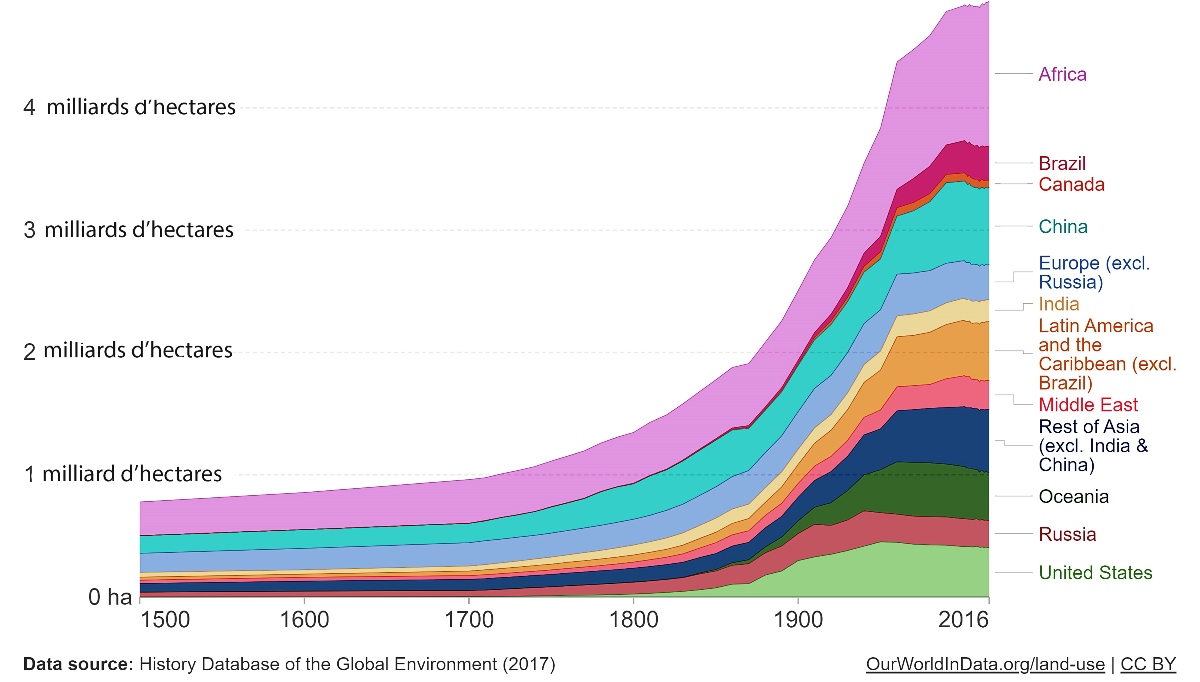
This historic growth is now reaching its limits. Indeed, as shown in the following illustration, established using data from an estimate of cultivable areas 12 . The latter represent only 6.4% of the earth's surface, which makes them a rare resource whose preservation is becoming a global issue, especially since they also play an essential role as a purifier and water reserve, in a time when we are beginning to feel the effects of global warming and their impact on our water supplies.
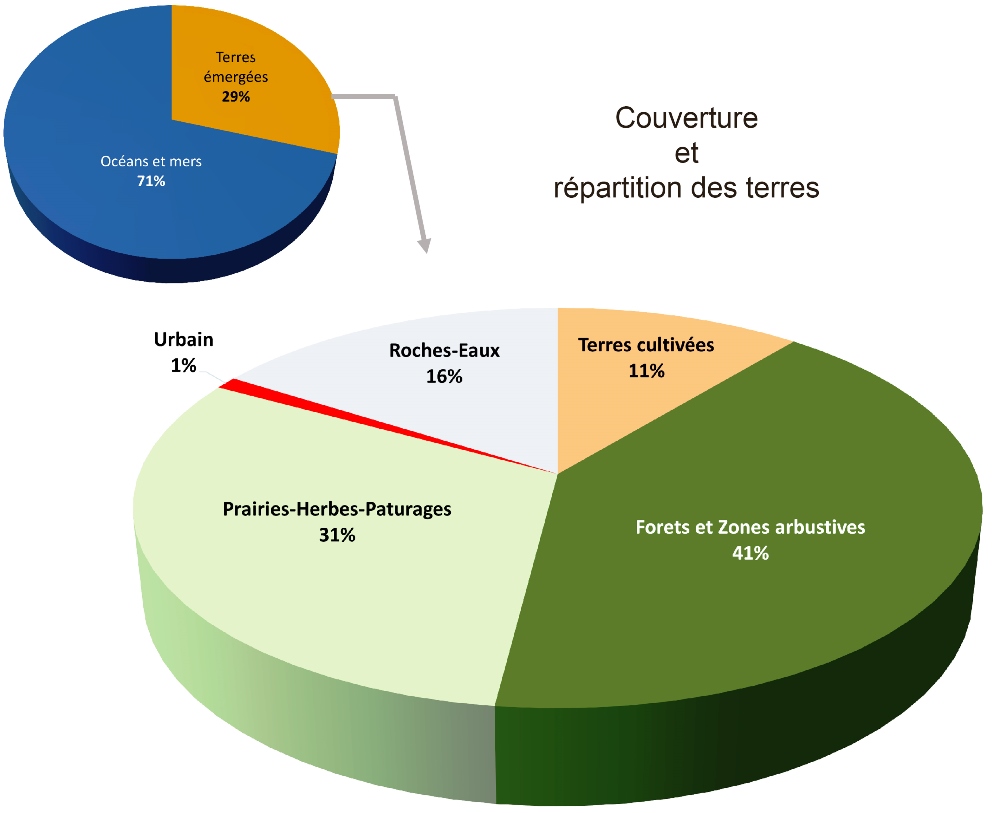
Since the beginning of the industrial era, we have observed an acceleration in soil deterioration, for the reasons mentioned above, but also because man is constantly intensifying the exploitation of resources, while releasing more and more waste. .
Despite repeated warnings from the scientific world, the disproportion between the speed with which man alters the soil and the duration necessary for the latter to regenerate continues to grow.
At the same time, the demand for agricultural products continues to grow at the rate of the world's demographics, while supporting the aspirations of people to raise their standard of living.
Even if all soils are not originally suitable for agriculture, the chemical industry proposes to overcome this by implementing non -permanent solutions which consist of spreading chemical fertilizers and other substances which only accelerate mineralization. and end up deteriorating natural biological regeneration processes.
Soil degradation therefore appears to be one of the most urgent problems to resolve.
6) Land degradation:
A major part of the degradation suffered by the soil results from our activities. The levels of alteration vary, but scientists note that today, 60% of cultivable soils are already affected.
The diagram below 13 illustrates the three types of degradation suffered by soils:
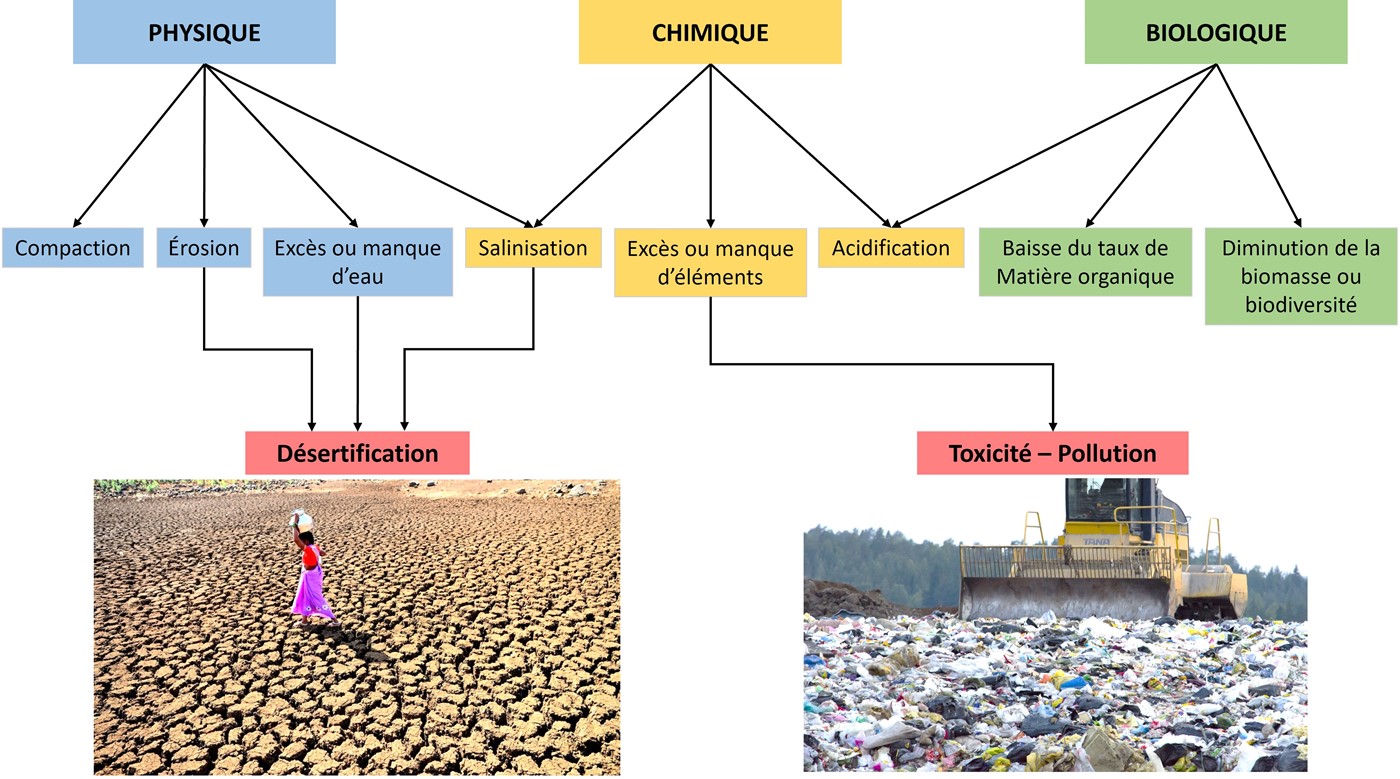
7) Degradation mechanisms:
· Compaction :
Soil compaction is nothing other than an increase in its density, often due to repeated passages of agricultural machinery or livestock which causes compaction. The earth thus becomes more compact and impervious to the water cycle. A first consequence results in a drop in yields, due to the difficulty of plants to root well in hardened soil.
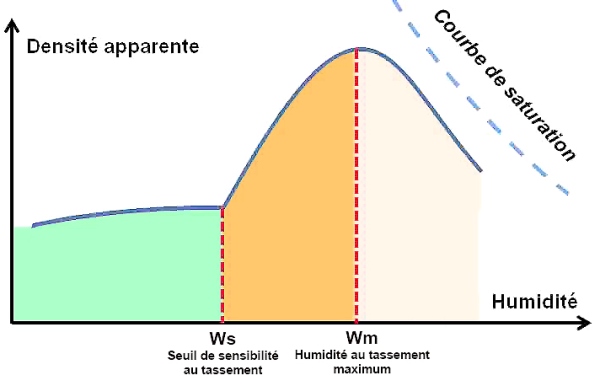 But soil compaction also has the effect of increasing atmospheric water runoff and the resulting erosion, while preventing groundwater from properly recharging.
But soil compaction also has the effect of increasing atmospheric water runoff and the resulting erosion, while preventing groundwater from properly recharging.
It is largely the chemical and organic composition of a soil that determines its water retention capacity, the latter having a direct impact on the soil's propensity for compaction.
The solutions to be implemented to limit soil compaction must therefore take into account a set of specific data, relating to the specific nature of each soil concerned.
The diagram opposite 14 , given as an example, shows the evolution of the compactness of a soil as a function of its water saturation rate. It appears that beyond a threshold ( Ws ), the increase in water content increases the sensitivity to compaction, up to a maximum value ( Wm ) close to saturation which defines maximum compactness. Beyond this point, the soil, saturated with water, becomes less sensitive to compaction again.
· Erosion :
Soil erosion brings together a set of processes which, on the surface of the soil or at shallow depths, remove all or part of the existing land and modify its relief.
Erosion can be seen visually, but it can also go partly unnoticed. Indeed, although on the surface, certain soils may seem unchanged to us, the same is not true in terms of their quality and their volume below the surface.
The erosion factors are multiple, we distinguish three:
- Water : Detachment of parts of the soil, transport and sedimentation of particles under the action of water.
- Cultivation : Result of work of the soil by man through his agricultural or forestry practices.
- Wind turbine : Detachment and dissemination of particles from the ground by the action of the wind.
If these factors are essentially physical, the same is not true for their physico-chemical impact on soils. Indeed, the fertility of a soil essentially depends on the mechanical properties of the upper layer which occupies the first centimeters. Erosion affects this layer made up of fine particles, more easily transported than coarse particles. However, it is precisely these particles (clay, silt, organic matter, etc.), which are decisive for soil fertility, which are the most exposed.
Studies show that when the first fifteen centimeters of soil are eroded, most of its chemical and biological fertility is affected in the very long term and sometimes even irreversibly.
· Excess or lack of water :
An agronomist 15 from the 19th century already mentioned this subject in these terms:
“Constant freshness within the arable soil is useful and even necessary for vegetation, but excessive humidity is always harmful to it. When water stays on the surface of the soil, it paralyzes the action of the sun's rays, causes the roots of a large number of plants to perish and some of the best plants in natural meadows to disappear; in addition, it reduces the effects of fertilizing materials and delays cultivation operations. (…) When we manage to remove the excess humidity from a land, the work is always carried out with less expense and more speed, the germination of the seeds is more perfect and the products better and more abundant. »
A water excess or deficiency occurs when soil is difficult to work and cultivated plants do not develop in good conditions. But this phenomenon can, as we have just mentioned, lead to a deterioration of its structure.
· Excess or lack of elements :
The fertility of a soil results from the variety and quantities of elements present there. There are several types:
- The major elements are nitrogen (N), phosphorus (P) and potassium (K) which plants cannot do without for their growth and to ensure correct yields.
- The secondary elements are calcium (Ca), magnesium (Mg) and sulfur (S). They are also necessary, but plants use much smaller quantities.
- The minor elements, also called trace elements, are boron (B), copper (Cu), iron (Fe), manganese (Mn), molybdenum (Mo) and zinc (Zn)… which are required in very small quantities (expressible in grams per hectare).
Although secondary and minor elements are consumed by plants in small quantities, compared to major elements, their role is essential. Their deficiency or overabundance can, in fact, cause significant damage to crops.
The overabundance of an element results, at the root level, in a reduction in the plant's capacity to absorb other elements or in a slowdown in transport within the plant.
A large number of interactions can occur. One of the best known relates to three elements ( Ca , Mg and P) whose optimal balance would be 10: 1: 1 (Ten units of Calcium for one of Magnesium and one of Phosphorus). In this context, the analysis of soil, prior to its agricultural exploitation, proves very useful. At the same time, we cannot ignore the toxic potential linked to the presence of heavy metals (lead, cadmium, mercury, etc.), often resulting from industrial waste, which make the soil unsuitable for agricultural exploitation.
However, everything would be too simple if there was an ideal floor. Each plant has specific needs, as illustrated in Table 16 below:

The management of the elements contained in a soil can be ensured through external inputs or specific practices, such as irrigation, which can modify the capacity of a soil to absorb one of the elements provided.
· Salinization:
It may be the result of natural alteration of mineral-rich rocks present in the soil. On a geological scale, we speak of “primary salinization”. It is mainly chlorides, including sodium chloride (cooking salt), which cause salinization. Today it is estimated that this phenomenon affects 7% of the world's land surface17.
The increase in intensive crops and the irrigation that goes with them also plays a growing role. In fact, 20% of cultivated land on our planet is irrigated with naturally mineralized irrigation water; whether they come from rivers or groundwater. When this water evaporates or is absorbed by plants during their growth, part of the mineral elements they contain are fixed in the earth.
The diagram below 18 illustrates the salinization process of irrigated soils. The blue arrows represent the movements of water and the white arrows, the migration of salts.

Fig.1: Irrigation water already containing mineral salts infiltrates into the soil, dissolving and carrying away the salts it contains.
Fig.2: Under the influence of the sun, the water loaded with dissolved salts rises to the surface by capillary action and evaporates.
Fig.3: As the salts contained in this water cannot evaporate, they are deposited on the surface.
Such a mechanism leads to salinization rates which quickly render the affected soils unsuitable for crops. We note that the spreading of fertilizers has effects, which are aggravated if the plants do not absorb all of the inputs.
Below. The main impacts of water imbalances on arable soils 19 .
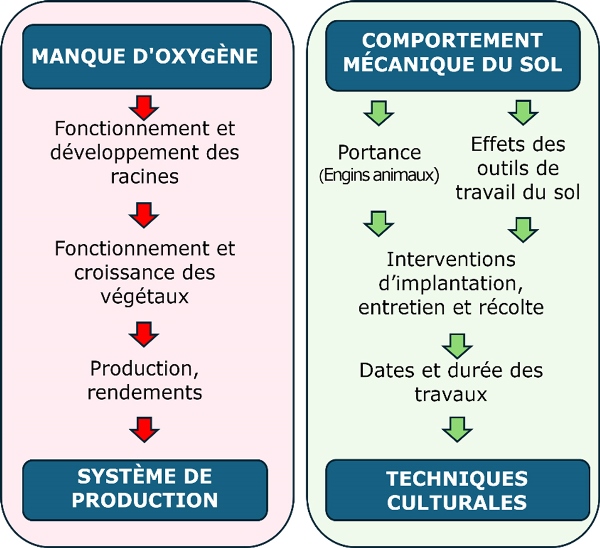
· Acidification:
The acidification of a soil is checked by measuring its pH over time. The pH or “hydrogen potential” makes it possible to measure the basic or acidic nature of a sample. A so-called neutral soil has an equivalent concentration of acids and bases, as illustrated below 20 .
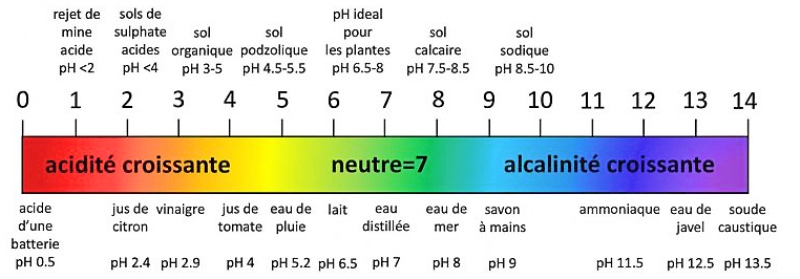
The Ph largely determines the propensity of a soil to be cultivated, depending on the nature of the plants that one wishes to grow there.
- Acidic soil (pH less than 5.5) is considered very poor, because it prevents certain elements such as phosphorus from being assimilated by plants.
- Basic soil (pH greater than 7.5) limits plant growth by significantly reducing their iron or magnesium absorption capacity. In this case, we observe a yellowing of the leaves (chlorosis).
We see that the lands most suitable for cultivation are those whose pH is in a range between 5.5 and 7.5.
Wanting to cultivate land located outside this niche requires external contributions. In the case of soils that are too acidic, we can apply lime or marl, while to lower the pH of alkaline soil, we can add peat, coniferous litter or manure.
The pH of a soil results from multiple factors:
- The use of so-called “nitrogenous” ammonia fertilizer.
- Too abundant irrigation which causes significant drainage and a loss of bases. - The nature of the parent rock (a volcanic, granitic or schistose subsoil will contribute more to acidifying the soils than a limestone parent rock). - The humification, resulting from the process of decomposition of organic matter. - Acid rain loaded with combustion residues from fossil fuels which also contain sulfur and nitrogen compounds. - A part of the minerals which make up the soil are absorbed by plants (Mg, Ca, K.) while others remain in the soil (Aluminium, Boron, Zinc, Iron). Their concentration increases over time until reaching lethal toxicity thresholds for plants. These multiple factors lead to a wide variety of soils, as illustrated in map 21 below:
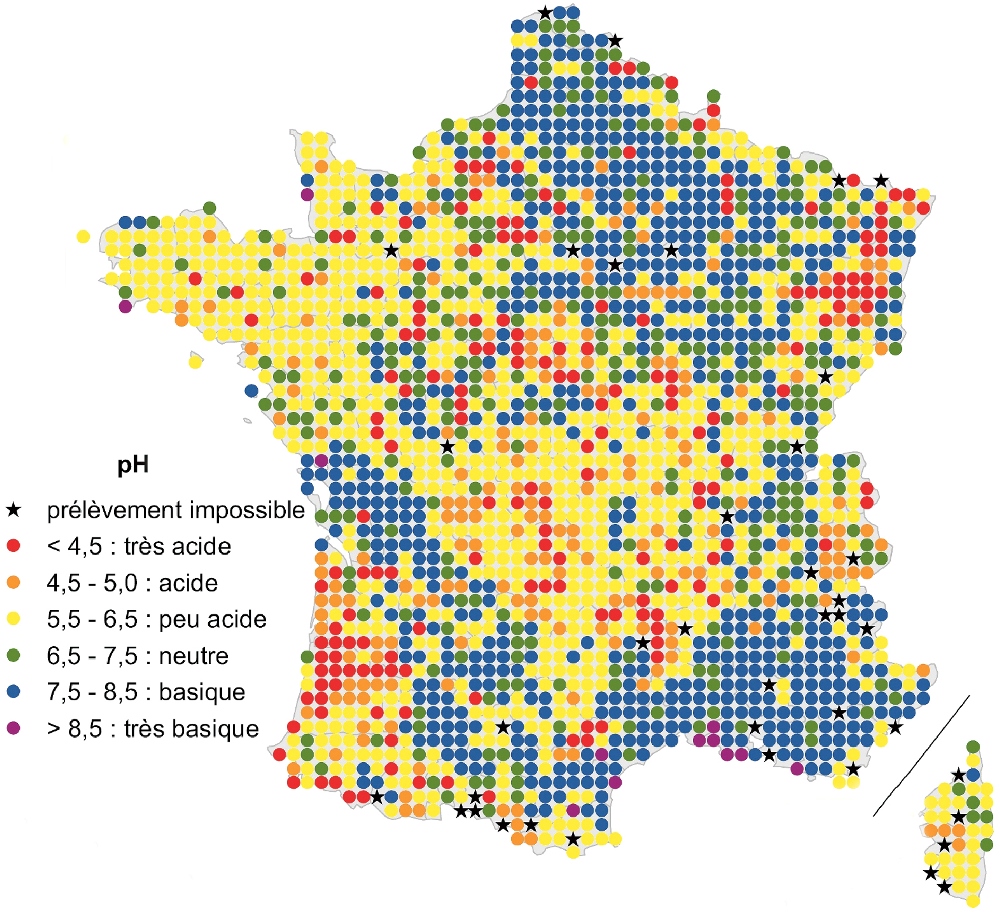
· Decrease in organic matter level:
The organic matter content of a soil is just as important as its elemental content. The presence of organic matter is essential for maintaining the biological activity of soils, but also for their structure, their water retention and drainage capacity and their nutrient reserves.
Organic matter is composed of:
- Living matter: Micro-organisms, nematodes, arthropods, algae, fungi, living roots, etc.
- Fresh organic residues: Crop residues or grindings and farm fertilizers (manure, slurry)... - Decomposing organic residues - Humus: Final stage of organic decomposition which generally represents the largest part of organic matter.
It impacts:
- The structure of the soil: a soil which becomes less compact, aerated, permeable to water and easier to work. This stabilization also allows the soil to be less sensitive to erosion (water and wind).
- Nutrient reserves: The biological decomposition of organic matter generates nitrogen and other nutrients. It contributes, through a process called cation exchange, to the fixation of nitrogen but also other elements such as potassium, magnesium and calcium. - The percentage of organic matter in a soil determines its level of richness. A content of less than 2% is considered to characterize poor soil. From 2% to 5%, the soil is average and, above 5%, it is considered rich.
· Decrease in biomass and biodiversity:
The soil is a “factory of life”. Microorganisms are found there, in which fungi represent 12% of the biomass and bacteria 7%. We also encounter, among others, protozoa, mites, springtails, earthworms, insects, crustaceans, myriapods, etc.
In soils, the distribution of biomass is not homogeneous, although it occupies all horizons from the surface to depths of up to eight meters. However, most living organisms evolve in the first twenty centimeters, although microbial biomass is present at greater depths, notably in forest soils.
For example, in a teaspoon, taken from untreated meadow soil, live more than 22 billion organisms represented by more than ten thousand species of bacteria and fungi.
Altering or degrading a soil amounts to endangering or eliminating these organisms which contribute to preserving its properties, thanks to the multitude of tasks that they tirelessly carry out: cutting, fragmentation, dissemination, regulation of populations, chemical transformations of elements, etc.
8) Soil organisms:
A quarter of the biomass evolves in the soil. However, few people know the diversity of the organisms that make it up. Although this does not constitute a survey, I asked the following question: “name some organisms that live in the soil” to a dozen people around me.
The earthworm being systematically cited first, the “top 5” answers are as follows,
- Earthworms
- The ants
- The crickets
- Moles
- The larvae
As we can see, what is perceived only represents a tiny part of reality. It is useful to remember that in addition to the life forms mentioned above, a multitude of other types of organisms evolve in the soil. Their small size (sometimes a few microns) makes them unnoticed despite their omnipresence.
Part of the biological cycle of soil organisms takes place on its surface or immediately below, mainly in decomposing organic matter. The three great kingdoms of life are represented there. Bacteria, archaea (possessing cells without a nucleus) and eukaryotes (uni or multicellular, with a nucleus, such as plants, animals including humans and fungi).
Important note : I limit myself in the following part to a few comments on the lesser-known organisms and only cite other groups without being exhaustive.
-
Bacteria:
Prokaryotes, unicellular which do not have a nucleus. The most basic organisms of life, they are also the most abundant within prokaryotes where we also find archaea . Prokaryotes are particularly present in the surface horizons of soils, their density decreasing with depth.
One of the particularities of prokaryotes is that they are capable of establishing symbiotic relationships with other organisms. For example, we know that the fixation of nitrogen contained in the air, then its conversion into nutrients assimilable by plants, results from the fixing action of certain algae, but also from a symbiotic relationship with the plant. This is the case for cyanobacteria which are not algae but photosynthetic bacteria.
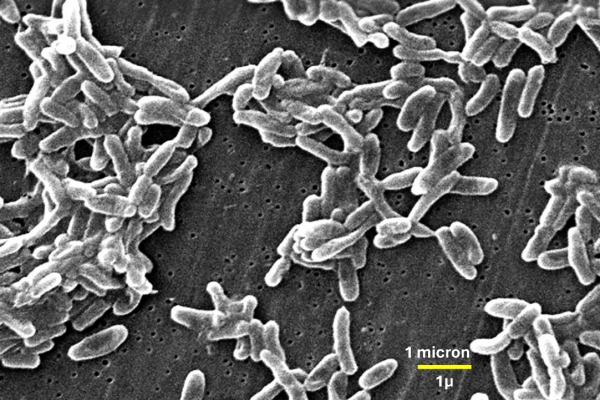 We know several hundred thousand species of bacteria (opposite 23 ), most of which have great metabolic versatility which allows them to adapt to almost all types of soil.
We know several hundred thousand species of bacteria (opposite 23 ), most of which have great metabolic versatility which allows them to adapt to almost all types of soil.
They can be useful auxiliaries: Actinobacteria (60% of the bacterial mass), which often appear in a filamentous form, frequently evolve in symbiosis with plants or fungi. They play an important role in the decomposition of organic matter and the formation of humus.
Other actinobacteria can be pathogenic to plants or animals. This is the case for the bacterium clostridium tetani which causes tetanus or for clostridium perfingens which causes gangrene.
Agronomically, soil bacteria can be classified into functional groups 24 :
- Ammonifiers, which break down organic nitrogenous substances into ammonia.
- Nitrifiers, which oxidize ammonia to produce nitrates. - Nitrogen fixers, which capture atmospheric nitrogen. - Cellulolytics , which degrade cellulose (the most widespread plant element).
Bacterial colonies develop in the presence of water, in the interstices of the aggregates. Their dissemination, outside the centers of development, depends on the diffusion of water and nutrients. Subject to climatic hazards (frost, desiccation, etc.), they alternate between dormant states and phases of reproduction and growth.
-
Cyanobacteria:
They are prokaryotes, capable of photosynthesis (transformation of light energy into chemical energy). They are very resistant to drought and, as a result, are capable of colonizing the driest soils on the planet. They play an important role in nitrogen fixation (see below).
Below colonies of filamentous cyanobacteria Nostoc.

Speaking of photosynthesis, we can see in this image larger spherical cells (heterocysts) which have the ability to fix nitrogen from the air to supply it to other cells (smaller links in these chains) which, due to their properties, photosynthetics, fix the carbon dioxide (CO2) contained in the air in the form of sugars. The fixation level is estimated to be between 10 to 25 kg/hectare/year. Cyanobacteria therefore promote soil fertility.
Note : Since their appearance on Earth, 1 to 1.3 billion years ago, algae and cyanobacteria have produced and released oxygen, helping to constitute our current atmosphere. Without the contribution of these microscopic organisms, it is likely that many other forms of life would not have been able to leave the aquatic environment to colonize the earth's surface. The oxygen contained in the air allows them to abandon gill respiration in favor of aerial respiration.
-
Algae:
Omnipresent in the soil, they are photosynthetic, just like cyanobacteria. Their dependence on light, contains them mainly on the surface of the soil. However, the presence of algae has been noted down to depths where light cannot reach (more than 15 to 20 cm). This presence can be attributed to the mixing of soils carried out by earthworms and to the ability of certain species to move by themselves, as soon as water is sufficiently present in the soil.
An active component of microbiological soil crusts, algae provide nutrient reserves for plants. To date, around forty prokaryotic algae and around a hundred identified eukaryotes live in soils. Among them, the cyanobacteria already mentioned, green algae, diatoms, brown algae and to a lesser extent, euglena and red algae.
Below:1( pediastrum boryanum ), 2 ( cosmarium ), 3 ( xanthidium ), 4 (euglena and its flagellum marked with a red asterisk)
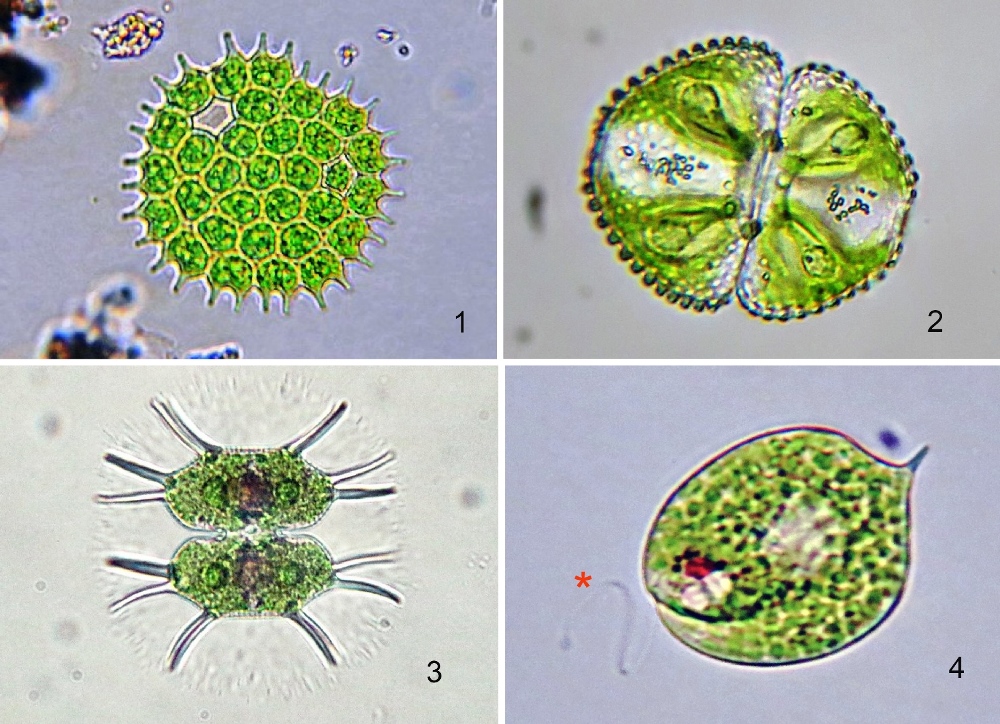
-
Diatoms:
Generally present in the salty waters of seas and oceans, they are also found in brackish waters, fresh waters of rivers and in the surface layers of soils provided that water is present there. These organisms are single-celled eukaryotes that can live in isolation or grouped together in colonies.
These are yellow or brown algae which have the ability to move and whose particularity is to be the only unicellular organisms to possess a siliceous external skeleton called a frustule. Diatoms have chloroplasts and are therefore capable of photosynthesis. Important suppliers of oxygen, they are essential to the marine ecosystem.
Below: 1. Amphora ovalis , 2. Gomphonema geminatum , 3. Diatoma mesodon in colony), 4. Meridion circulare in colony.

-
Mushrooms:
Mushrooms come in a wide range of varieties. The mushrooms that we consume are in fact only a part (the reproductive part) of more complex organisms that live below the surface of the soil. They constitute a significant part of the biomass of the latter and come in two forms:
- Unicellular: . This is the case, for example, with yeasts.
- Multicellular: These have microscopic filamentous branches called hyphae which group together in the form of cords called mycelium (which springtails are fond of).
Mushrooms, like bacteria, work to decompose plant debris and promote the production of humus. They emit enzymes through the walls of their cells capable of degrading dead organic matter, such as the cellulose contained in wood.
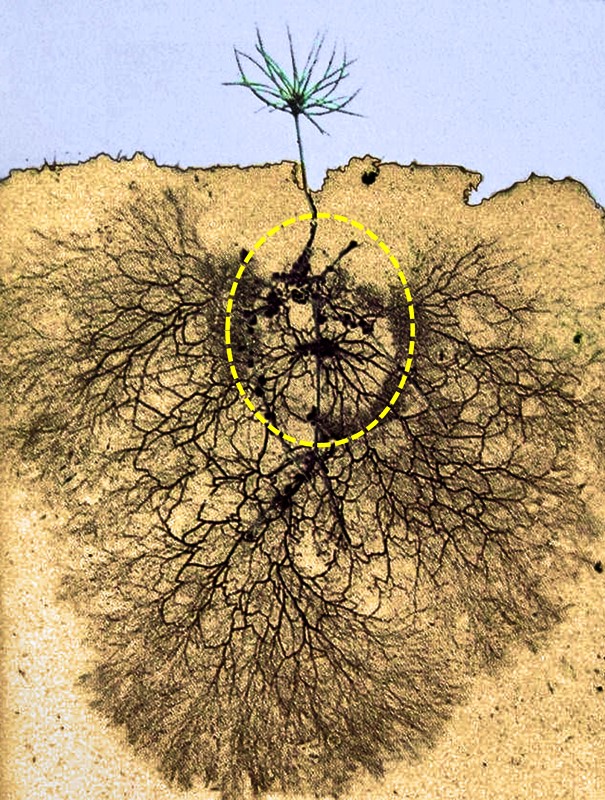 Certain fungi, which are neither decomposers nor parasites, live with plants in a beneficial interdependent relationship. Mycorrhizae illustrate this relationship in an alliance between plant roots and mushroom mycelia.
Certain fungi, which are neither decomposers nor parasites, live with plants in a beneficial interdependent relationship. Mycorrhizae illustrate this relationship in an alliance between plant roots and mushroom mycelia.
Mechanism : The plant's chlorophyll photosynthesis provides the fungi with the sugars necessary for their growth. In return, the fungus provides the plant with minerals and water which it draws thanks to its deep ramifications, much more developed and efficient than the roots of the plant itself (a majority of plants resort to this type of exchange with the mushrooms).
The illustration opposite 25 shows the symbiosis between a very young maritime pine and a mushroom. We can see the extent of the mycelial network of the symbiotic fungus, relative to the root system of the pine, much less branched and delimited by the perimeter drawn in yellow.
Note : Spreading chemical fertilizers rich in phosphates on crops has the paradoxical effect of killing the mycorrhizal fungi which themselves supply phosphorus.
Thus, the plant, just like the person who cultivates it, becomes dependent on external inputs, for the sole benefit of the agrochemical industry...
Below: 1.Collembola Neelus murinus (0.3mm) grazing on hyphae, 2. Boletus Edulis – edible Bordeaux porcini mushroom, 3. O ïdium - Single-celled pathogen, 4. Alternaria (20 to 80 µ) - Airborne pathogen and allergen, causing health problems in man and animals.
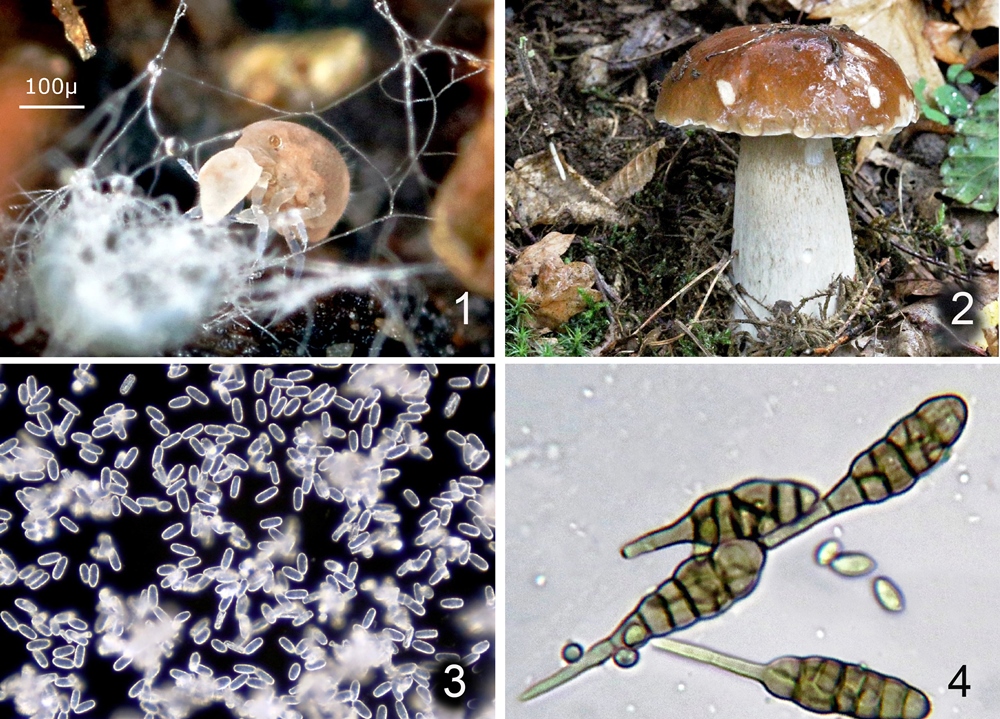
-
Myxomycetes:
These organisms, also called amoebas with true plasmodia, are quite mysterious and come in varied shapes and colors. The life cycle of myxomycetes includes two main stages:
Nutritional stage: Mobile stage during which it can move at speeds of around 1 cm/hour. It is then predatory and takes the form of a plasmodium to explore its support, on which it phagocytizes its “prey” like an amoeba. Its targets are bacteria, yeasts, cyanobacteria, green algae, spores, molds and small fungi, whose populations it helps to regulate.
Reproductive stage: When the plasmodium has accumulated sufficient nutrient reserves, it comes to rest and forms sporocysts which are small spheres of varied colors containing spores which will be disseminated by the wind or by soil microfauna. Myxomycetes represent a fraction important of the unicellular soils in which they move, feed and transform, participating in the process of organic decomposition. They are mainly found on dead wood and in litter.
Below is a Plasmode on which we notice the presence of a springtail ( Lepidocyrtus ) which “sips” it (red asterisk).
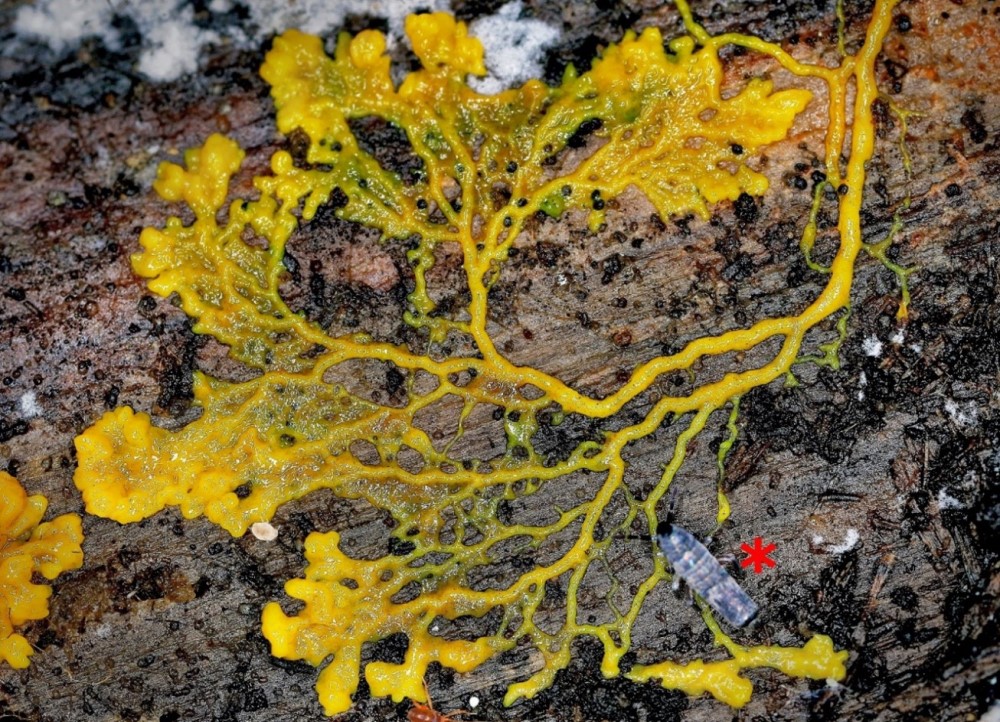
Below: 1. Trichia affinis immature, 2. Lipogala epideendrum beginning its transition to the reproductive stage, 3. Trichia decipens , 4. Lampoderma sauti (two sporocytes ). Anne-Marie Rantet -Poux , specialist in slime molds, helped me with the identifications.
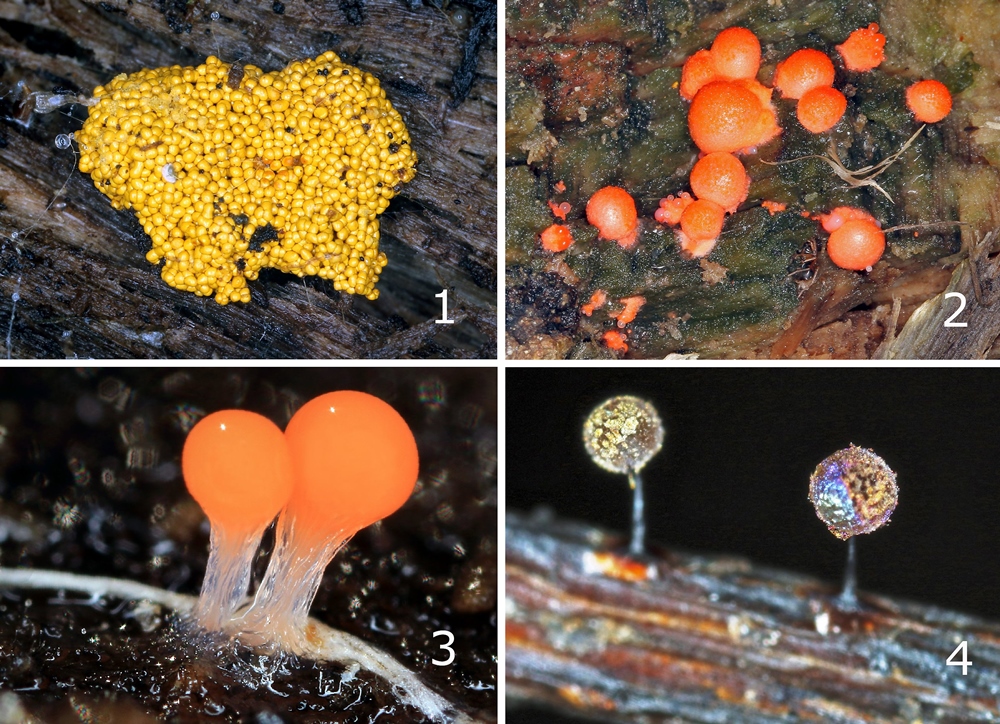
-
Protozoa:
Unicellular eukaryotes, their size generally microscopic and between 10µ and 50µ Very exceptionally, it can be around 1mm. Their food consists of carbon materials or compounds excreted as sugars by other organisms. They find their resources by feeding on bacteria, algae or fungi. They are also decomposers capable of degrading organic matter and are among the important players in soils.
When they feed, they act on the bacterial biomass by releasing elements useful for the soil. In fact, the nitrogen contained in the bacteria that they consume, and from which they also draw carbon, is released in the form of ammonium, which can be directly assimilated by plants.
To date, we know of more than 30,000 species living in aquatic environments or in soil. Their density varies depending on the nature of the soil. A teaspoon's worth of soil may contain only a few thousand in poor soils, but it can exceed 1 million cells in fertile soils.
Furthermore, the humidity of a soil is decisive for the types and density of protozoa which colonize it. Their morphologies allow us to classify them into four groups:
- Ciliates: Their cell membrane is equipped with mobile cilia that they use to move.
- Amoeboids: Capable of deforming to ensure their locomotion and phagocytose their prey. Thecamoebians form an important group often used as indicators of the quality of natural environments. Thecae are in fact preserved after the death of the amoeboids and their presence makes it possible, thanks to retrospective analyses, to reconstruct the paleoenvironments.
- Flagellates: Equipped with flagella-shaped organelles which help them to move.
- Sporozoa: Parasites of animals, they produce spores.
Note : The following plate is shown for information purposes only, because it only contains aquatic protozoa (I have never had the opportunity to photograph protozoa taken from the soil): 1. Ciliated n.id. , 2. B lephairsma.sp -ciliate, 3. Dolflugia –theca amoeba, 4. Centropyxis aculeata -Theca amoeba, 5. Amoeba sp . Amoeba, 6. Coleps hirtus – ciliated.
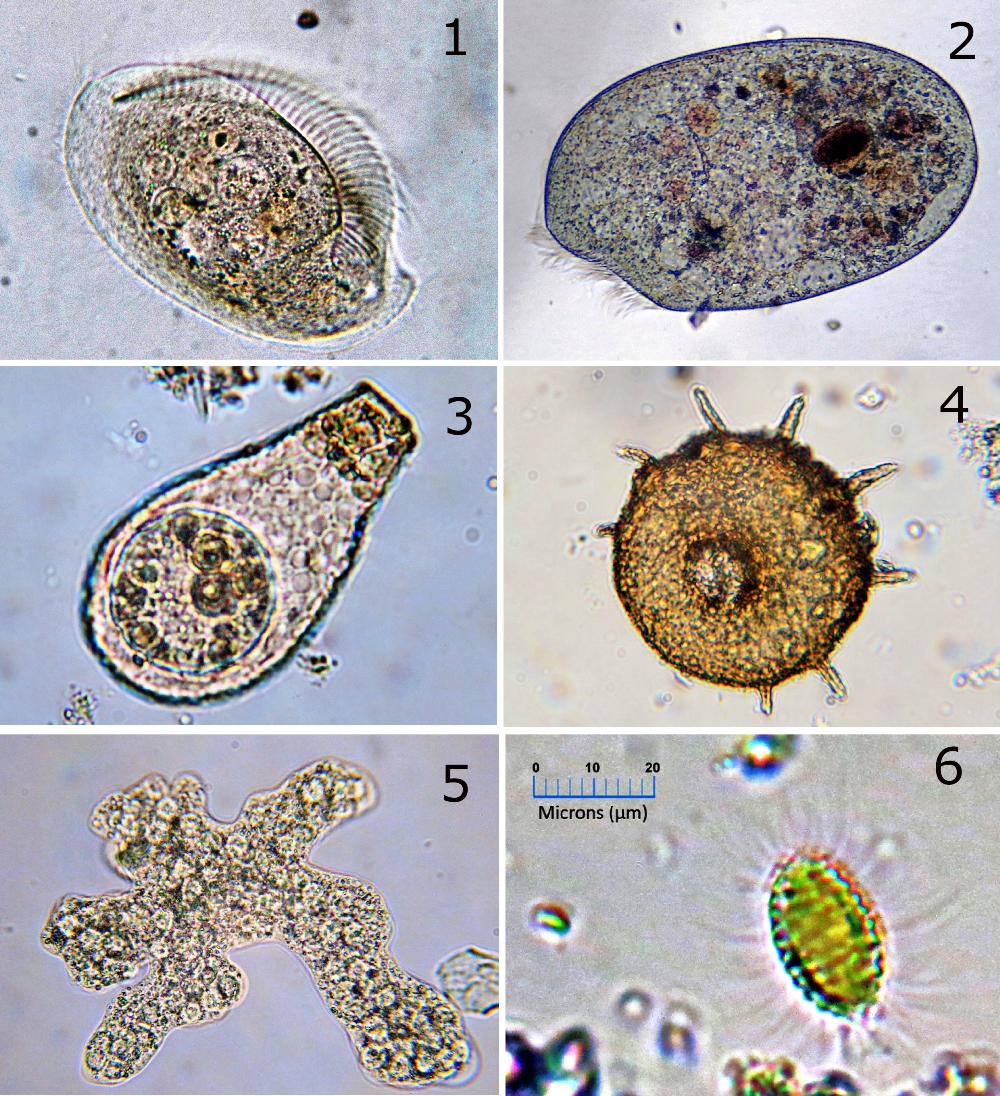
-
Tardigrades:
Commonly called “water bear”, its discovery and first descriptions date from the 18th century. Its attested presence on Earth dates back to the Cretaceous era (-60 to -80 Ma). Today there are more than 1000 species which colonize all the biotopes of the planet and possess extraordinary abilities of resistance to extreme conditions of temperature (from -270°C to 150°c), dehydration, pressure (they tolerate both vacuum and pressures up to 6000 bars), radiation (ultraviolet, X-ray). Capable of considerably reducing its metabolism to a state called stasis, it can then remain like this for up to thirty years, upon contact with a humid environment it returns to its initial state and begins to evolve naturally. Observing this phase under a microscope is a real spectacle.
Tardigrades are found both in marine ecosystems and in the highest mountainous regions. Terrestrial species are found mainly in mosses and lichens. Their size hardly exceeds 1mm. Their body has four pairs of legs whose ends have hook-shaped claws.
They feed mainly by hunting rotifers, nematodes and protozoa and they have an elongated stylet which they use to perforate their prey from which they suck up the substance. During their life, which can last up to two years, they undergo a large number of moults.
Below, photographic montage from images taken under a Trinocular microscope.
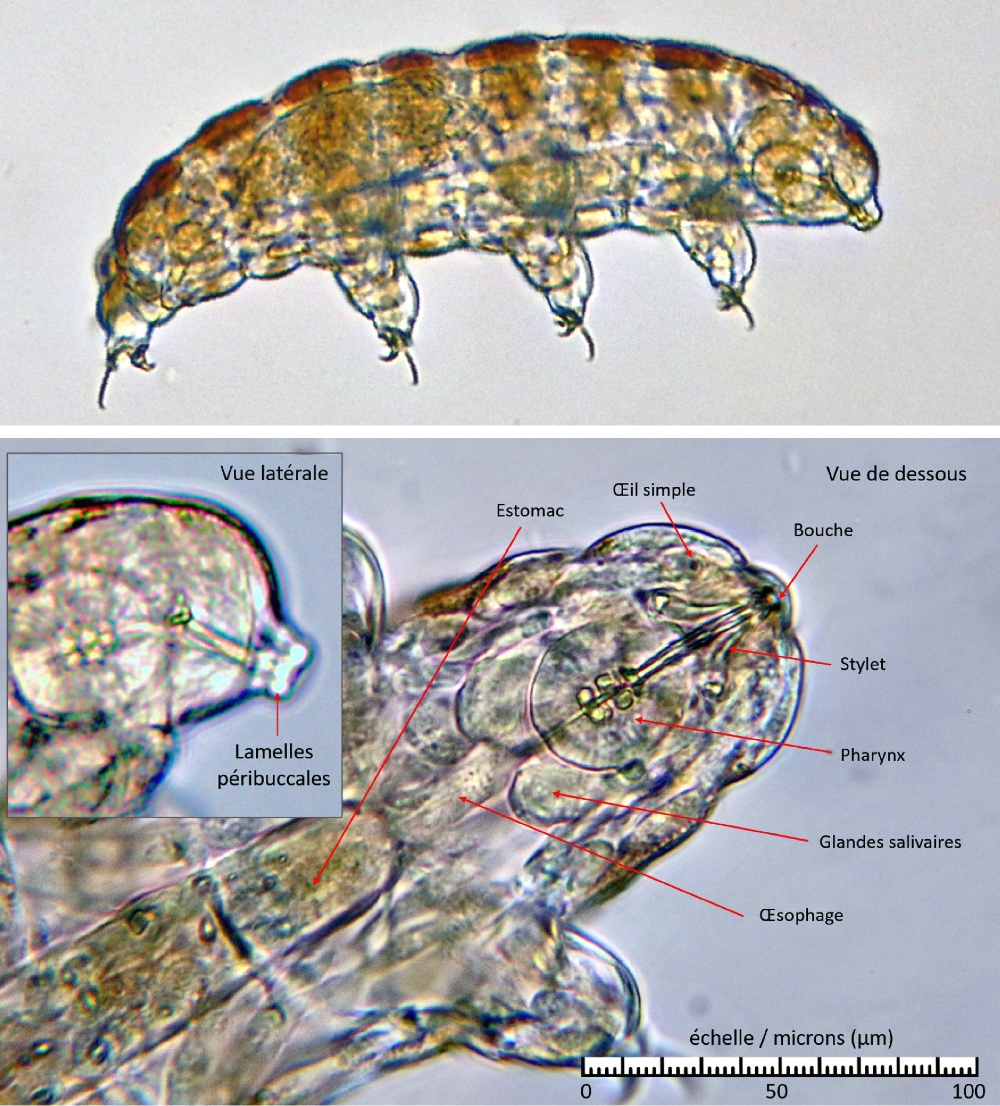
Rotifers:
These tiny organisms (0.2 to 0.4 mm) are very abundant in the surface layers of soil and in litter. They move by crawling or using the crowns of eyelashes they have. Depending on the humidity contained in the soil, their density can vary from a few units to 200 individuals per cm². Although their number is high, there are only around 2000 species. Occupying a small part of the soil biomass, they are not considered a key group.
The two classes most present in soils are:
- Bdeloids which are perpetuated by parthenogenesis (their eggs can hatch without being fertilized). They are capable of going into anhydrobiosis, in other words, slowing down their biological functions to withstand high desiccation rates. They thus go through the driest periods and can survive by maintaining this state for several years. Anhydrobiosis is reminiscent of the cryoprotective dehydration used by certain populations of springtails present in polar zones.
- Monogononts which primarily occupy fresh water and which are rarely found in soils.
The diet of rotifers consists of very small prey. Thanks to their crowns of cilia, they stir the liquids to extract bacteria, yeasts or fragments of algal cells. They represent a food resource for other soil organisms such as nematodes or tardigrades.
To see them in action, I suggest viewing two videos: rotifer in stirring action and rotifer in movement .
Below: 1. Notholca squamula , 2. Lecane sp . 3. Philodina
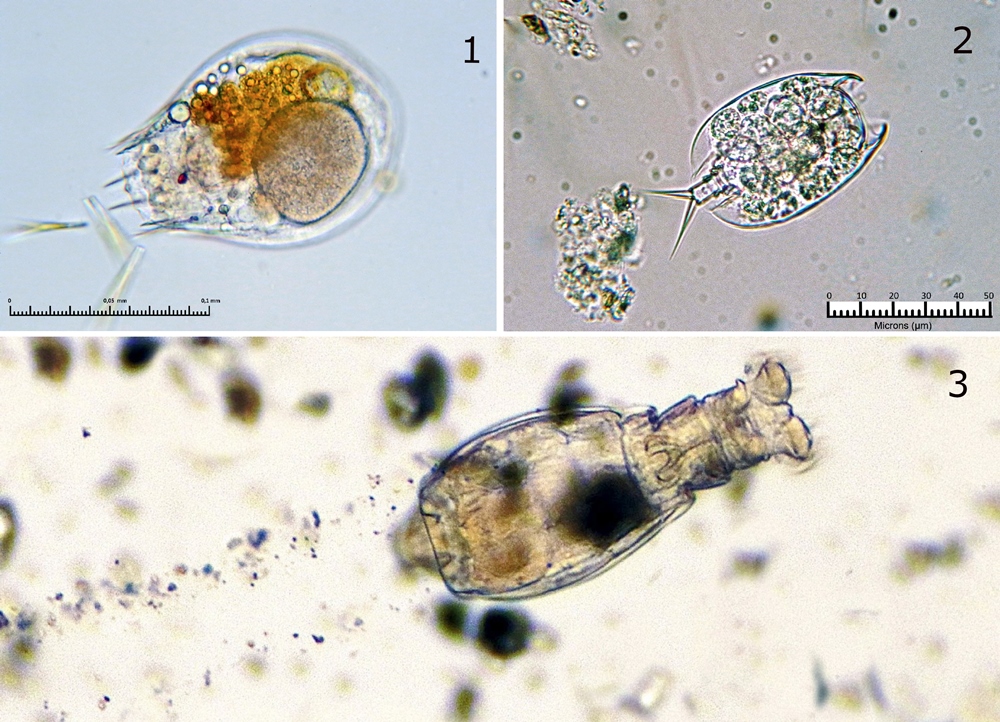
-
Nematodes :
Nematodes are non-segmented cylindrical worms. The size of those that live in the soil does not exceed a few millimeters (although there are some that reach 8 meters in length). They are present in almost all ecosystems, from Antarctic soils to hot springs of volcanic origin.
They are found in the water films of the gaps or in the wettest areas of the litter. There are eight groups identified according to their diets, the five main of which are bacterivores, fungivores, omnivores, phytoparasites , predators.
They are considered a key species in the soil ecosystem where they play a role in decomposition and mineralization. The species found in soils depend on multiple environmental factors, such as the availability of resources, the plant species that grow in these soils or the chemical nature of the latter.
Nematodes can also, when they move, carry with them colonies of bacteria attached to their cuticle. Here we have a form of phoresis.
Some nematodes that parasitize mammals can be fatal. For example, Diroflaria immitus is known to settle in the hearts, arteries and lungs of dogs and cats. However, the majority of nematodes are not harmful.
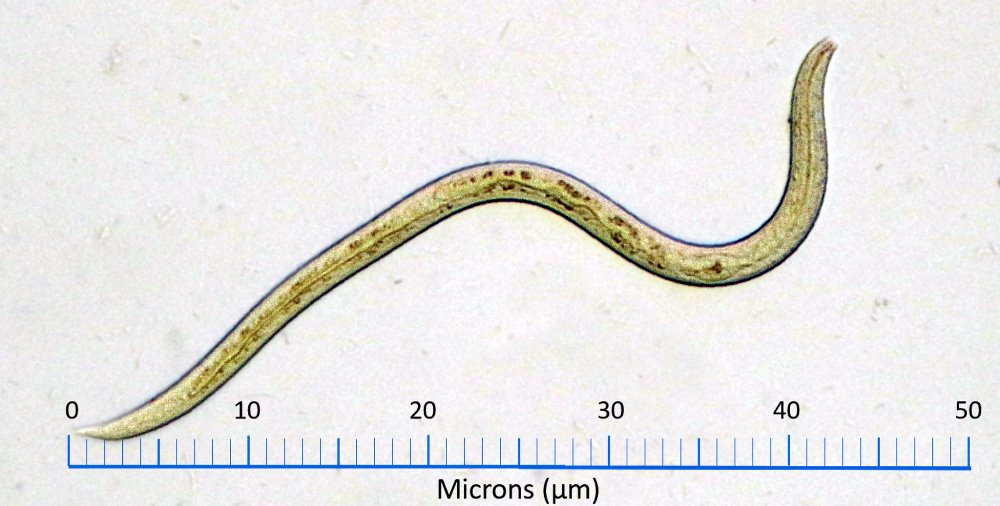
-
Mites:
These small arachnids (0.2 to 0.8 mm) are among the most abundant in soils; more than 48,000 species have been counted to date. Their average density is around a few thousand individuals/m² but, in some cases, it exceeds 100,000 individuals/m².
They are found in all types of soil, on the aerial parts of plants or parasitizing other animals (ticks, varroa, etc.). They are capable of withstanding extreme climatic conditions and therefore colonize the entire planet. Mites that live in the soil are generally blind, while some of those that live on the surface have cells on their dorsal part that are sensitive to light. Their cuticle carries sensitive hairs, pores or vacuoles which serve as mechanical or chemical receptors and which can be compared to the trichobothria of springtails (see: setae and sensilla of springtails ).
Mites prefer moist soils rich in organic matter in which each species presents characteristics specific to the various environmental conditions and food resources present.
Their contribution is diverse. Some are carnivorous predators that hunt small arthropods or smaller organisms, thus participating in the regulation of their populations. Others parasitize plants by drawing food through the roots. Macrophytophages consume plant fragments or organic residues .
Like other animals, mites can transport certain organisms (fungi, bacteria) which they spread. By breaking up plant debris and releasing their faeces, they also enrich the humus in the soil.
Below: 1. Dermatocentror marginatus ( tick - 5 mm ) , 2 . _ _ pteridis , 5. Acarus siro present on the rind of Cantal cheese – (0.3mm), 6. Linopods sp . ( Eupodidae ).

-
Springtails:
( Refer to the content of this site )
Role: Detritivores, fragmentor , disseminator, regulator, prey.
Below : 1.Billobella aurantiaca ( poduromorph ), 2. Dycyrtoma fusca ( Symphypleone ), 3. Orchesella villosa ( Entomobryomorphe ), 4. Neelus murinus ( Neelidae )

-
Myriapods:
Role: Detritivore, fragmenter , disseminator
Below: 1. Blaniulus guttulatus ( julida ), 2.Scolopendra cingulata ( sculopendridae ) 3.Scutigera coleoptrata ( scutigeromporpha ) 4.Polynexus lagurus ( plynexidae , 5. Geophilus.sp ( geophilidae ).
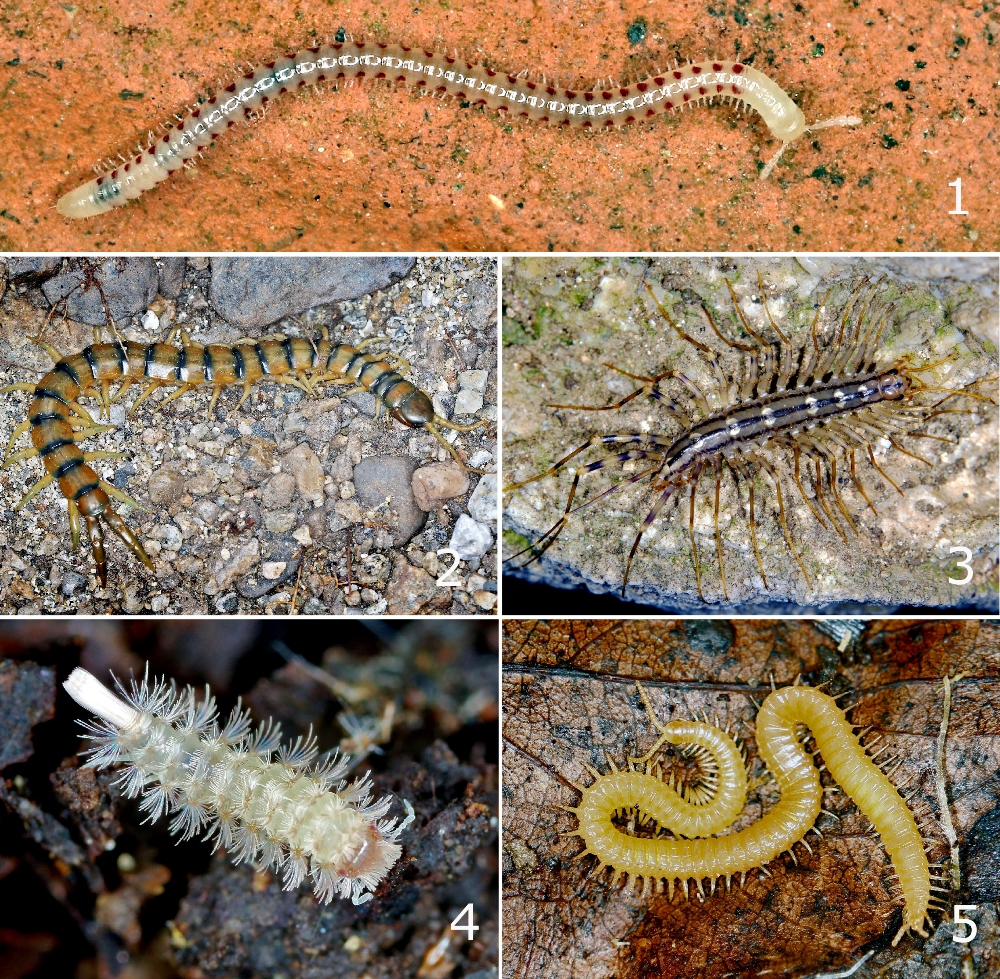
-
Earthworms :
Earthworms are among the organisms essential for soil quality. The primary terrestrial animal biomass, they consume organic matter and decomposing plants.
In one year and on one hectare of unpolluted meadow, 250,000 worms (on average) ingest and reject between 300 and 600 tonnes of soil 26 . They carry out a mixing under our feet comparable to the work of our largest construction machines, thus acting on the very structure of the soil.
Their galleries facilitate water infiltration, limit runoff and erosion. They help aerate the soil and facilitate the circulation of nutrients to the roots of plants. In addition, these galleries allow the root system to increase their exchange surfaces. By depositing their droppings and mucus on the galleries, they enrich the soil with sugars, which stimulates and diversifies the microorganisms, resulting in an enrichment of the soil with nutrients.
Role: Fragmenter , buryer, brewer, recycler of organic matter, predator, prey.
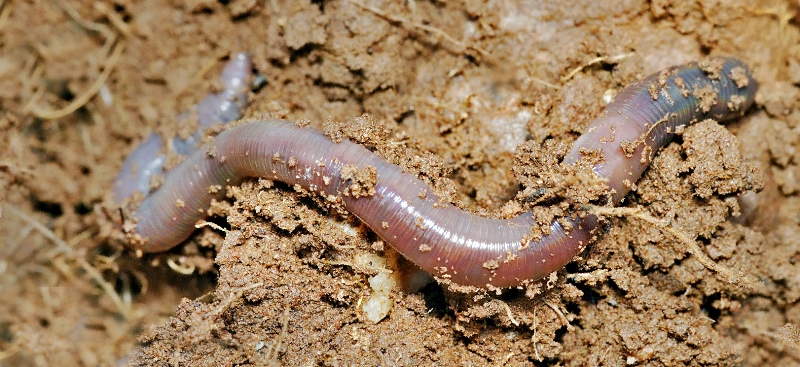
-
Ants :
Hymenopterous insects, ants, hosts of the soil, play an important role due to their diversity and their significant biomass. They are also excellent bioindicators, used by many researchers for monitoring ecosystems.
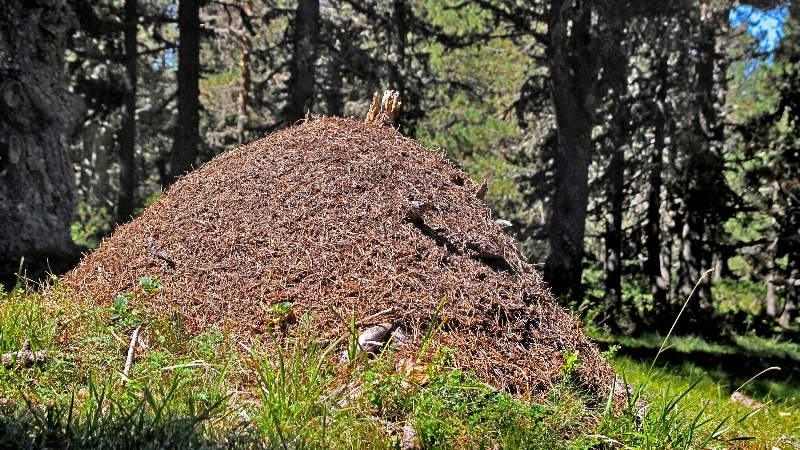
Today there are more than 16,000 species of ants that live in colonies (anthill, above). They contribute to soil aeration and the decomposition of organic waste, whether of plant or animal origin. Some ants can live for more than 25 years, this is the case of Lasius niger presented below (n°3). Their movement in search of food also promotes the dispersal of seeds. Some ants can live for more than 20 years, this is the case of Lasius Niger presented below. The mass of all ants living on Earth exceeds that of the human population.
Below: 1. Camponotus vagus (exchange of information between a “minor” worker and her “major” sister) 2. Crematogaster scutellaris (nursery), 3. Lasius niger (Taking care of an aphid colony), 4. Myrmica sp . (Predatory).
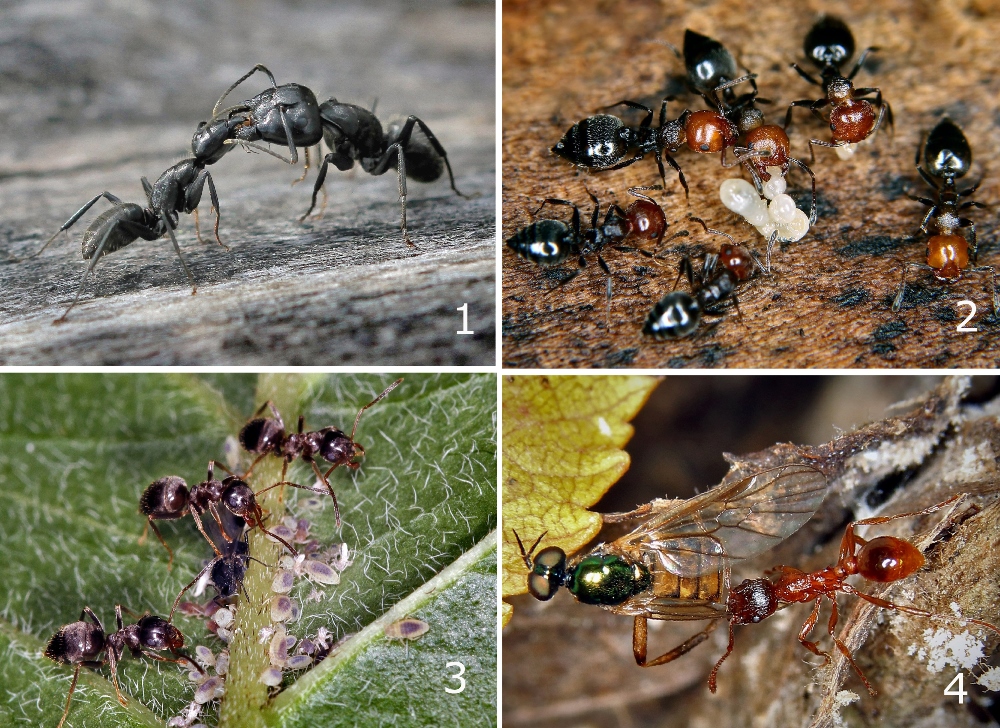
-
Isopods:
Most of the species in this order of crustaceans are marine. The most familiar terrestrial isopods are woodlice which colonize dead trees and litter. They avoid sunlight to avoid desiccation. They feed on decomposing plant matter and promote the supply of nutrients to the soil.
Role: Detritiphage, cleaners, disseminator.
Below: 1.Philoscia muscorum (terrestrial), 2.Ligia italica (marine), 3.Armadillidium vulgare (terrestrial) on the right in protective position).
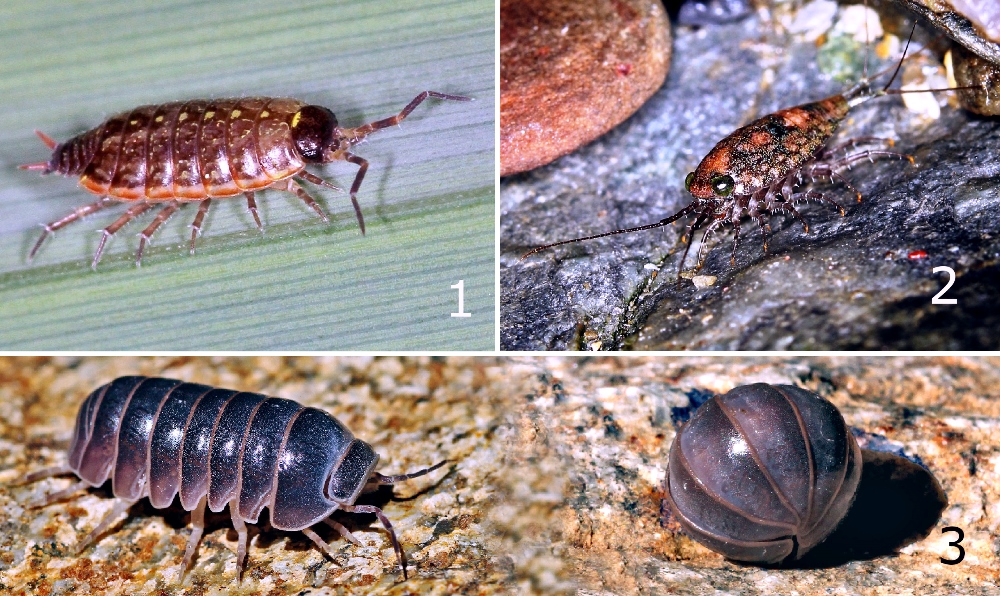
-
Beetles:
Important family with wings whose distribution of species is linked to the nature of the soil and the vegetation which hosts them. Beetle larvae develop mainly in decomposing organic masses (old tree trunks) and in soils where they feed mainly on plants and fungi, but some species can be carnivorous. Adult beetles live in the open air.
Role: Pollinator, detritivore, regulators, fragmenters , biomass transformers, prey for other species (insects, birds, reptiles, small mammals)
Below: 1.Larva and adult Pyrochroa coccinea , 2.Larva and adult Coccinella septempunctata , 3. Larva and adult Orycte nasicornis .
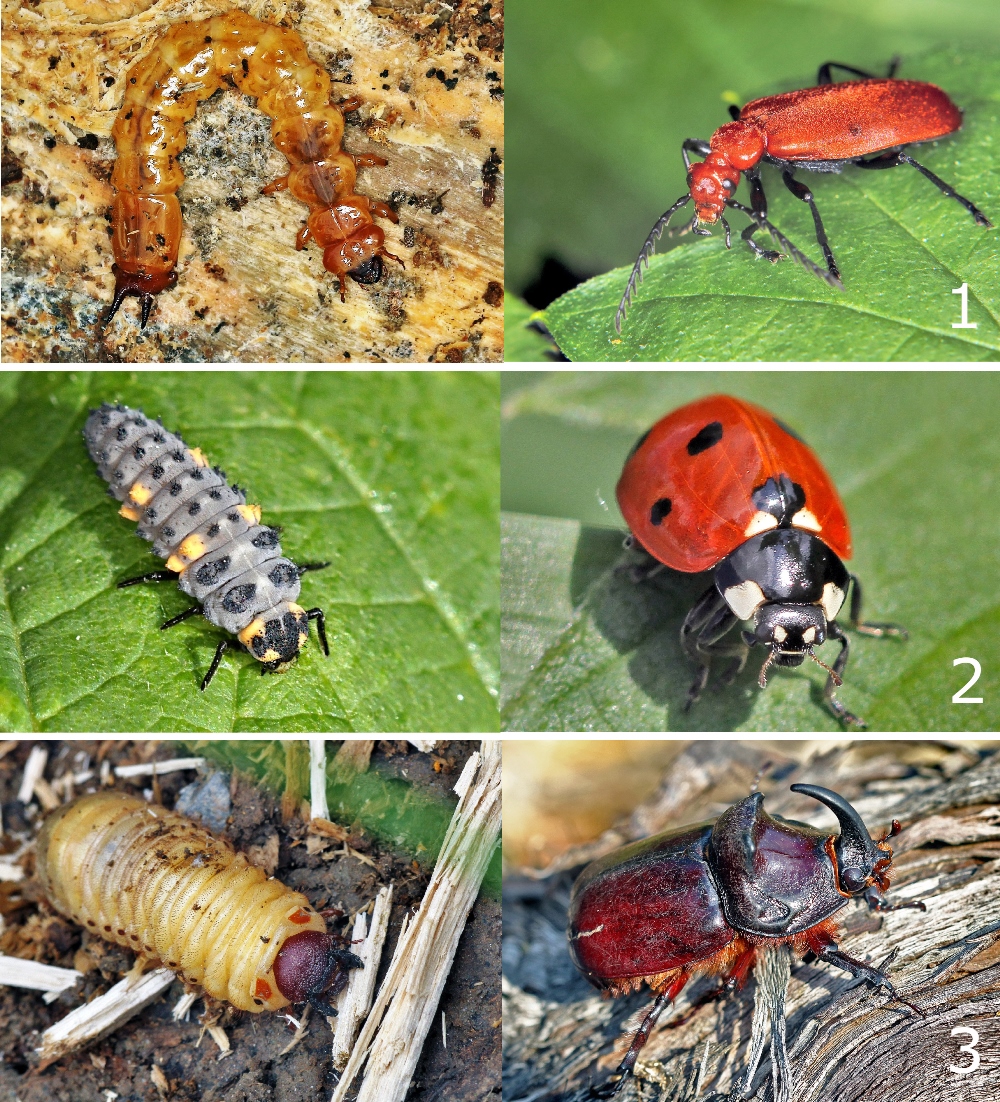
-
Other soil-dwelling organisms:
- Cochlostoma and 2. Helicodonta obvula (gastropods), 3.Psocoptera, 4.Thysanoptera, 5 Campodea (Diploura), 6. Pseudoscorpion (arachnids)
-
Tahe mole :

Finally, how can we not mention the mole and its earthworks (molehill above). This mammal that lives in the ground moves large quantities of earth to dig its burrow and multiple galleries. It is estimated that a mole digs up to 200 meters of tunnel in its territory. This mixing promotes aeration and loosening of the soil as well as the dissemination of nutrients.
Below European mole27

Unlike mole rats, the mole is exclusively carnivorous and feeds mainly on earthworms, larvae, slugs and insects, of which it eats daily quantities of between a third and half of its weight. Molehills expose the soil and create porous mounds which form micro-habitats likely to be colonized by pioneer species. They thus contribute to plant and animal biodiversity.
9) The impossible equation?
After this review of soil life, we can only agree with the idea that this composite, organo -mineral whole, forms a complex biotope with fragile balances. Each element or organism that constitutes them could be compared to the stone of an architectural vault whose destruction would cause the entire building to collapse.
Our survival today depends on our ability to use the planet's soils sparingly. But, as Clément Mathieu points out, the soil remains “the great forgotten one” and its preservation does not seem to be a global priority.
At a time when food needs continue to grow, agriculture is trying to respond, supported by omnipresent agrochemicals. The powers in place, despite their displayed awareness, struggle to make the necessary decisions and remain prisoners of a globalized economy, more oriented towards the sustainability of profits than that of resources.
If, moreover, the abandonment of all unsustainable land use on a global scale were planned, this would be equivalent to prohibiting the populations of developing countries from accessing decent standards of living. While the affluent populations, who are also the best informed, still do not seem willing to fundamentally question their way of life.
The equation is therefore not easy to resolve, given a fixed situation which does not invite optimism.
Sources and useful links:
NB; All photographic illustrations of living organisms come from my personal photos , excluding mentions ( bacteria-worms )
2 Olivier de Serres (1539-1619): Considered the father of French agronomy, he is the author of a treatise “ Theater of Agriculture and Field Farming ”
3 Henri Louis Duhamel de Monceau (Bpt.1700 – 1782): French botanist and agronomist; considered one of the founders of modern agronomy and forestry.
4 Johan Gottschalk Wallerius (1709 – 1785): Swedish chemist and mineralogist. Considered one of the founders of agricultural chemistry. Book “ agriculture reduced to its true principles ”
5 Julius von Liebig (1803 – 1873): German chemist who contributed to the progress of organic chemistry and agronomy. Considered one of the founders of industrial agriculture.
6 Jean Baptiste Boussingault (1801 -1887): French chemist, botanist, agronomist. Considered the founder of modern agricultural chemistry, who became famous, among other things, for his discoveries on nitrogen dynamics, fat metabolism, photosynthesis efficiency.
7 Sir John Bennet Lawes (1814 – 1900): English entrepreneur and scientist. Founder of an experimental farm which became a research center in which he developed superphosphate, thus marking the beginning of the use of chemical fertilizers.
8 Vassili Vassilievitch Dokuchaev (1846 -1903) Russian geographer considered the father of pedology who is credited with being the first scientist to have carried out a vast study of soil types.
9 Otto Friedrich Müller (1730 – 1784) was a Danish naturalist. Recognized as an important author in the knowledge of microscopic beings, he established an inventory of all forms of life in his country.
10 Eugène W.Hilgard (1833 – 1916) German-American expert in pedology. An authority on climate as a factor in soil formation and the regeneration of alkaline soils. He is considered the father of modern soil science in the United States.
11 Source: https://ourworldindata.org/grapher/total-agricultural-area-over-the-long-term
12 Adaptation by me of a “SAGE-GTAP” graph from an information report n°504 , filed on 04/18/2015
13 Diagram adapted by me from Michel Robert and Pierre Stengel “ Resources in danger ” CIRAD and article by Clément Mathieu on the Planet VIE website.
14 Diagram adapted, from fig.1-p.142 of the publication: “ Knowledge of the physical and mechanical behavior of soils in Eastern France. » (Faure, 1971 & 1978; Grimaldi, 1981; Guérif , 1982).
15 Gustave Heuzé , “Agricultural France” 1891, vol. 1: 66. Source: Excess water by Gérad Trouche and Pierre Morlon
16 Table from “ Prevention of deficiencies in minor and secondary elements in organic soils ” Mario Leblanc, agronomist – publication of the Ministry of Agriculture of Canada.
17 Article “ soil salinization ” Environmental Encyclopedia.
18 Diagram from fig 5.11: “ Soil chemistry ” Darshani Kumaragamage ; Jim Warren; and Graeme Spiers
19 Chains of consequences and disadvantages linked to excess water in agricultural land – Excess water: consequences . Gerad Trouche and Pierre Morlon
20 Diagram from fig 5.9: “Soil chemistry” Darshani Kumaragamage ; Jim Warren; and Graeme Spiers
21 ( Map ©INRAE – Gis Sol ).
22 European Atlas of Soil Biodiversity - © European Union, 2013.
23 Photo: © Judith Noble-Wang , Ph.D , USCDCPG
24 Supagro.fr. “ Soil organisms ”.
25 Article researchgate : Image modified, from photo © Professor Sir David Read, FRS.
26 CNRS: https://www.cnrs.fr/cw/dossiers/dosbiodiv/index.php?pid=decouv_chapC_p5&zoom_id=zoom_c1_8
27 Image on left : Joseph Sardin : https://www.flickr.com/photos/14328577@N08/4586323763 - Image on right : Jacques Chibret : https://www.flickr.com/photos/jac31/3184636433
Recommended sites:
https://planet-terre.ens-lyon.fr/
https://www.encyclopedie-environnement.org/auteurs/
